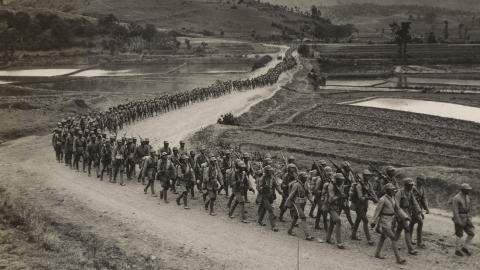On May 10, 1940, Adolf Hitler’s forces set out to conquer France and the Low Countries. Their lightning warfare known as Blitzkrieg took all opposing forces by surprise and their swift advance through the so-called impenetrable Ardennes forest left the French defences in chaotic disarray. Within a matter of weeks, Paris was occupied unopposed. The Wehrmacht had revolutionised warfare.
The Germans had realised that speed combined with quick and decisive battles was now the key to military success. Their Blitzkrieg tactic depended on air superiority, fast tanks, constant radio communication and a relentless advancing infantry to achieve its shock and awe purposes. The tactic enabled the Germans to gain more territory in less than 100 hours than they’d achieved in 4 years during the First World War.
However, the element of surprise was critical to German success. The German generals who opposed the Ardennes route feared surprise would be lost since the soldiers would need to rest up at night. Yet, when the campaign was launched the soldiers relentlessly marched day and night to reach the French border in just a few days.
How did they achieve such a superhuman feat? Was the Nazi propaganda to be believed? Was it the sheer will of the German people and destiny of the Aryan master race to conquer all those who opposed them or did Hitler’s army have a secret weapon up their sleeve?
After their defeat in WWI, the German economy fell into ruins and the Great Depression of the 20s and 30s hit the country hard. Drug use amongst the population gradually got out of hand, with widespread cocaine and opiates abuse. Whilst the Weimar Republic, the German government from 1919 to 1933, struggled to recover the German economy, the country’s pharmaceutical companies were bucking the trend. Drugs had become available on every street corner.
In 1938, the German Temmler pharmaceutical company began advertising the sale of their new flagship product – Pervitin. Described as the ultimate pick-me-up, the drug quickly became a sensation with people praising its performance-enhancing abilities. From housewives to actors, the drug was soon being consumed across all walks of German society, at a frequency that would have you believe it was just a regular sweet. Aided by the fact Pervitin could be initially purchased without a prescription, the wonder drug became the country’s new addiction.
It didn’t take long for the drug to seamlessly make its way into the armed forces, a match that would soon be heralded as one made in military heaven. Pervitin combatted fatigue, triggering a heightened state of alert and renewing the consumer with a fresh wave of motivation and concentration. It allowed people to work for longer and in the world of a soldier where sleep was the enemy, Pervitin became the cure. It also raised self-confidence giving the consumer a sense of invincibility, which led to an increase in risk-taking. In every which way the drug provided people with a ‘neuronal firework’.
At the same time, it dulled feelings of empathy, hunger and thirst and reduced sensitivity to pain. It was the perfect weapon for turning soldiers into ultimate fighting machines...and the Nazi's knew it.
Otto Ranke, a military doctor and director of the Institute for General and Defense Physiology at Berlin's Academy of Military Medicine began testing the drug and although he discovered side-effects he concluded it was, ‘An excellent substance for rousing a weary squad…a militarily valuable substance.’
Pervitin was a powerful methamphetamine better known today as 'crystal meth'. It had already been used during the Polish campaign of September 1939 and by May 1940 was being manufactured for soldiers in the millions.
According to Norman Ohler, author of Blitzed: Drugs in Nazi Germany, 'Pervitin really helps a person to become a fighting robot, imagine this on the scale of a couple hundred-thousand people, heavily armed and storming into enemy territory, it just becomes a completely crazy situation.'
On 17 April 1940, German leadership issued to all doctors in the armed forces the unprecedented Stimulant Decree, a first in military history. 'The experience of the Polish campaign has shown than in certain situations, military success was crucially influenced by overcoming fatigue in a troop on which strong demands had been made. The stimulants are available for the interruption of sleep, Pervitin has been methodically included in medical equipment.'
The recommended dosage was one tablet per day and two at night, with the effects of each tablet lasting up to 12 hours. The Germany army was now the first in the history of warfare to officially rely on a chemical drug.
As Hitler’s forces fearlessly marched into France with crystal meth flowing through their veins, a new kind of war was being unleashed. ‘Blitzkrieg was guided by meth, if not to say Blitz was founded on meth,’ Medical historian Dr Peter Steinkamp is quoted as saying in Ohler’s book.
Letters from the front line shed light on the mass dependence and addiction to Pervitin that the German soldiers soon began suffering from. Soldiers would write home begging for more Pervitin and it had been given the nickname Panzerschokolade, or ‘tank chocolate’ by the German Panzer crews.
It took until 1941 for it to be classified as an intoxicant and an illegal drug by the Nazi Reich Health Leader, Leo Conti. Writing in a letter quoted in Ohler’s book, Conti stated, ‘an entire nation…was becoming addicted to drugs. The emergence of a tolerance to Pervitin could paralyse whole sections of the population…Anyone who seeks to eliminate fatigue with Pervitin can be quite sure that it will lead to a creeping depletion of physical and psychological performance reserves, and finally to a complete breakdown.’ Conti’s ban, however, was hardly observed and as Hitler’s tanks rolled into Russia for Operation Barbarossa, Pervitin consumption increased further.
The anti-drug rhetoric that Hitler and his party had spouted to aid their rise to power in the early 30s was based entirely on hypocrisy. The Nazi’s had treated drug addicts as criminals and flaunted their Fuhrer as the pure saviour who would clean up Germany and restore it to its former glory. Yet just a few years later the country would wage a war with crystal meth lining the pockets of every German soldier, with their beloved Fuhrer high on a cocktail of drugs provided to him by his personal physician, Dr Theodor Morell.
Morell, a former ships doctor in the tropics who’d set up a popular clinic in Berlin, was known by the mid-30s as the best and most discreet doctor in town. After treating Heinrich Hoffman, the official Reich photographer for gonorrhoea, he was introduced to Hitler by Hoffman. Hitler was suffering from severe abdominal pains and after Morell alleviated the symptoms with a tablet of healthy intestinal bacteria called Mutaflor, Hitler made him his personal physician in 1936.
From that point until the end of the war, Morell saw Hitler more than any other person. He administered him with over 800 injections, cocktails containing some 74 different substances from cocaine to morphine, testosterone and animal hormones to opiates and stimulants like methamphetamines. Morell’s so-called ‘Vitamultins’ or vitamin supplements for the Fuhrer increased in potency as the demands of war took a toll on the ever-weakening Hitler.
'I always had to carry out short treatments with high dosages,' wrote Morell in his notes, 'and had to go to the boundaries of the permissible, even though many colleagues would have condemned me for it. But I did and can bear the responsibility, because if treatment had been suspended at the present time, Germany would have been brought to its knees.’
By April 1945, Hitler had become used to consuming multiple pills a day along with numerous injections. Some have theorised that by the time he took his own life in the Führerbunker he was showing early signs of Parkinson’s disease. Ohler believes he was also demonstrating signs of withdrawal symptoms since the factories supplying the drugs for Morell were being bombed.
In the end, it is more than fitting that the Fuhrer, the man who refused to drink alcohol or eat meat, should best epitomise the paradox and flagrant hypocrisy of Nazism.
















